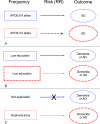Sex and gender differences in the causes of dementia: a narrative review
- PMID: 24954700
- PMCID: PMC4169309
- DOI: 10.1016/j.maturitas.2014.05.008
Sex and gender differences in the causes of dementia: a narrative review
Abstract
This is a narrative review of new ideas and concepts related to differences between men and women in their risk of developing dementia or Alzheimer's disease (AD). We introduce the concept of dimorphic neurology and the distinction between sex and gender. We then provide three examples of risk factors related to sex and gender from the literature. Apolipoprotein E genotype is equally common in men and women but has a stronger effect in women. Apolipoprotein E genotype is a biological factor that cannot be modified but interacts with sex or gender related factors that can be modified. Low education has a similar harmful effect in men and women but has been historically more common in women. Education is a social factor related to gender that can be modified. Finally, bilateral oophorectomy is a factor restricted to women. Bilateral oophorectomy is a surgical practice related to sex that can be modified. Consideration of risk and protective factors in men and women separately may accelerate etiologic research for neurological diseases in general, and for dementia and AD in particular. Similarly, future preventive interventions for dementia should be tailored to men and women separately.
Keywords: APOE genotype; Dementia; Education; Gender; Oophorectomy; Sex.
Copyright © 2014 Elsevier Ireland Ltd. All rights reserved.
Figures

References
-
- Exploring the Biological Contributions to Human Health: Does Sex Matter? The National Academies Press; Washington, DC: 2001. - PubMed
-
- Carter CL, Resnick EM, Mallampalli M, Kalbarczyk A. Sex and gender differences in Alzheimer's disease: recommendations for future research. Journal of Women's Health. 2012;21:1018–23. - PubMed
-
- Woods NF, Tsui AO. Editorial: Epidemiologic approaches to women's health. Epidemiol Rev. 2014;36:1–4. - PubMed
-
- Women's Health Research: Progress . Pitfalls, and Promise. The National Academies Press; 2010. - PubMed
Publication types
MeSH terms
Substances
Grants and funding
LinkOut - more resources
Full Text Sources
Other Literature Sources
Medical
Miscellaneous

